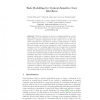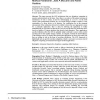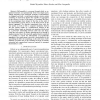240 search results - page 29 / 48 » Adaptive Organizations and Emergent Forms |
TSP
2010
13 years 3 months ago
2010
Abstract--A cooperative approach to the sensing task of wireless cognitive radio (CR) networks is introduced based on a basis expansion model of the power spectral density (PSD) ma...
DSVIS
2001
Springer
14 years 1 months ago
2001
Springer
Abstract. With the explosion of devices, computing platforms, contextual conditions, user interfaces become more confronted to a need to be adapted to multiple configurations of t...
CSCW
2008
ACM
13 years 10 months ago
2008
ACM
This article presents a rational model developed under the distributed cognition framework that explains how social tags influence knowledge acquisition and adaptation in explorat...
IJIPT
2007
13 years 9 months ago
2007
: This paper presents the ANS architecture that uses ubiquitous computing to monitor medical patients in the home. Since there is no notion of the patient carrying out maintenance ...
ICRA
2008
IEEE
14 years 3 months ago
2008
IEEE
Abstract— Self-assembly is a process through which an organized structure can spontaneously form from simple parts. Taking inspiration from biological examples of self-assembly, ...



